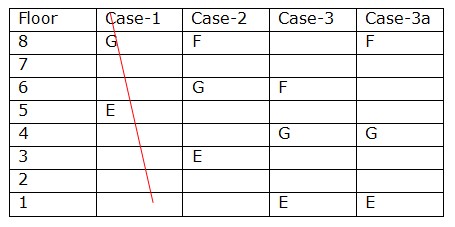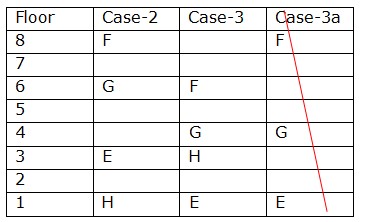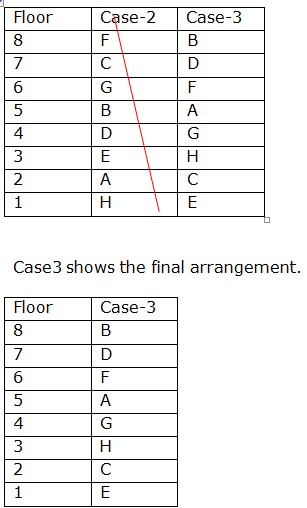Question
Which of the following statement(s) is/are true?
I) Three floors are between A and E II) B lives on the lowermost floor III) D lives two floors above A Study the following information carefully and answer the below questions Eight persons- A, B, C, D, E, F, G, and H are living in the eight-storey building. The lowermost floor is numbered as one and the topmost floor is numbered as eight. No two persons live on the same floor. G lives three floors above E who lives on an odd numbered floor. F lives above G but not on an odd numbered floor. The number of floors above F is the same as below H. B lives immediately above D. The number of floors between D and A is the same as between H and E. C lives below A.Solution
We have, G lives three floors above E who lives on an odd numbered floor. From the above condition, there are three possibilities.  Again we have, F lives above G but not on an odd numbered floor. From the above condition, case1 gets eliminated.
Again we have, F lives above G but not on an odd numbered floor. From the above condition, case1 gets eliminated.  Again we have, The number of floors above F is the same as below H. From the above condition, case3a gets eliminated.
Again we have, The number of floors above F is the same as below H. From the above condition, case3a gets eliminated.  B lives immediately above D. The number of floors between D and A is the same as between H and E. C lives below A. From the above condition, case2 gets eliminated.
B lives immediately above D. The number of floors between D and A is the same as between H and E. C lives below A. From the above condition, case2 gets eliminated. 
Which of the following extensions is used to save an image on a computer?
The primary function of a 'router' in a network is to:
In computer terminology, a file's unique identifier given at the time of creation is known as-
What is the extension of a Microsoft Word document created in recent software versions?
The search results are generally presented in a line of results often referred to as :
Which of the following is a part of the system unit?
What does 's' stand for in https?
The process of verifying that someone is who they claim to be is called:
What does 'RAM' stand for?
Which of the following is the illegal act of duplicating software for commercial or personal use?
Relevant for Exams:



